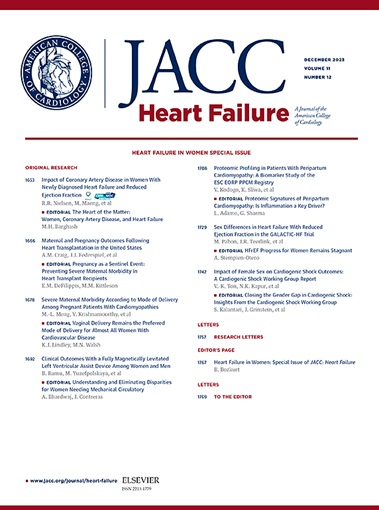心衰患者eGFR下降50%后的预后
IF 10.3
1区 医学
Q1 CARDIAC & CARDIOVASCULAR SYSTEMS
引用次数: 0
摘要
在心力衰竭(HF)试验中,肾小球滤过率(eGFR)估计下降50%已被引入作为一个新的肾脏终点。然而,其预后意义超过HF诊断后的最初6个月,在此期间患者通常接受药物治疗优化,仍然不确定-特别是对于没有糖尿病的患者。目的:本研究旨在确定eGFR下降对全因死亡率和终末期肾病(ESKD)风险的长期预后影响。方法:作者对2014年至2021年间诊断为HF的所有新发患者进行了全国性队列研究。从诊断后6 - 12个月评估eGFR轨迹,将患者分为3组:稳定eGFR(下降25%)、25%-50%下降和50%下降。只有在诊断后第一年存活的患者被纳入具有全因死亡率和ESKD主要结局的里程碑分析。结果45385例HF患者(中位年龄73.6岁,男性63.8%)中,82.5% eGFR稳定,14.2%下降25%-50%,3.3% 1年下降50%。在非糖尿病患者中,eGFR下降25%与5年死亡率增加相关,稳定eGFR、下降25%-50%和下降50%的绝对风险分别为33.2%、53.8%和63.0%。糖尿病患者的绝对死亡风险普遍较高,但趋势相同(稳定eGFR者分别为42.8%、58.6%和65.6%,下降25%-50%和50%)。发生ESKD的风险也随着eGFR的下降而增加。在无糖尿病患者中,稳定eGFR、25%-50%下降和50%下降的绝对风险分别为3.3%、7.9%和11.5%,而糖尿病患者发生ESKD的绝对风险明显更高(稳定eGFR、25%-50%下降和50%下降分别为7.4%、15.6%和21.1%)。结论:在这项大型现实世界研究中,无论糖尿病状态如何,eGFR下降50%与死亡率和ESKD风险增加相关,强调了其临床相关性。本文章由计算机程序翻译,如有差异,请以英文原文为准。
Prognosis After >50% Decline in eGFR in Heart Failure Patients
Background
A 50% decline in estimated glomerular filtration rate (eGFR) has been introduced as a new kidney endpoint in heart failure (HF) trials. However, its prognostic significance beyond the initial 6 months following HF diagnosis, during which patients often undergo medical therapy optimization, remains uncertain—particularly for patients without diabetes.
Objectives
This study aims to determine the long-term prognostic implications of eGFR decline focusing on risks for all-cause mortality and end-stage kidney disease (ESKD).
Methods
The authors conducted a nationwide cohort study of all new-onset patients diagnosed with HF between 2014 and 2021. eGFR trajectory was assessed from months 6 to 12 post-diagnosis categorizing patients into 3 groups: stable eGFR (<25% decline), 25%-50% decline, and >50% decline. Only patients who survived the first year post-diagnosis were included in the landmark analysis with the primary outcomes of all-cause mortality and ESKD.
Results
Among 45,385 patients with HF (median age: 73.6, 63.8% male), 82.5% had stable eGFR, 14.2% had a 25%-50% decline, and 3.3% had >50% decline at 1 year. In patients without diabetes, eGFR decline >25% was associated with increased 5-year mortality, with absolute risks of 33.2%, 53.8%, and 63.0% for stable eGFR, 25%-50% decline, and >50% decline, respectively. In patients with diabetes, absolute mortality risk was generally higher but followed the same trend (42.8%, 58.6%, and 65.6% for stable eGFR, 25%-50% decline, and >50% decline, respectively). The risk of developing ESKD also increased with eGFR decline. In patients without diabetes, absolute risks were 3.3%, 7.9%, and 11.5% for stable eGFR, 25%-50% decline, and >50% decline, respectively, whereas the absolute risk of ESKD was notably higher in patients with diabetes (7.4%, 15.6%, and 21.1% for stable eGFR, 25%-50% decline, and >50% decline, respectively).
Conclusions
In this large real-world study, a >50% eGFR decline was associated with increased mortality and ESKD risk irrespective of diabetes status, underscoring its clinical relevance.
求助全文
通过发布文献求助,成功后即可免费获取论文全文。
去求助
来源期刊

JACC. Heart failure
CARDIAC & CARDIOVASCULAR SYSTEMS-
CiteScore
21.20
自引率
2.30%
发文量
164
期刊介绍:
JACC: Heart Failure publishes crucial findings on the pathophysiology, diagnosis, treatment, and care of heart failure patients. The goal is to enhance understanding through timely scientific communication on disease, clinical trials, outcomes, and therapeutic advances. The Journal fosters interdisciplinary connections with neuroscience, pulmonary medicine, nephrology, electrophysiology, and surgery related to heart failure. It also covers articles on pharmacogenetics, biomarkers, and metabolomics.
 求助内容:
求助内容: 应助结果提醒方式:
应助结果提醒方式:


